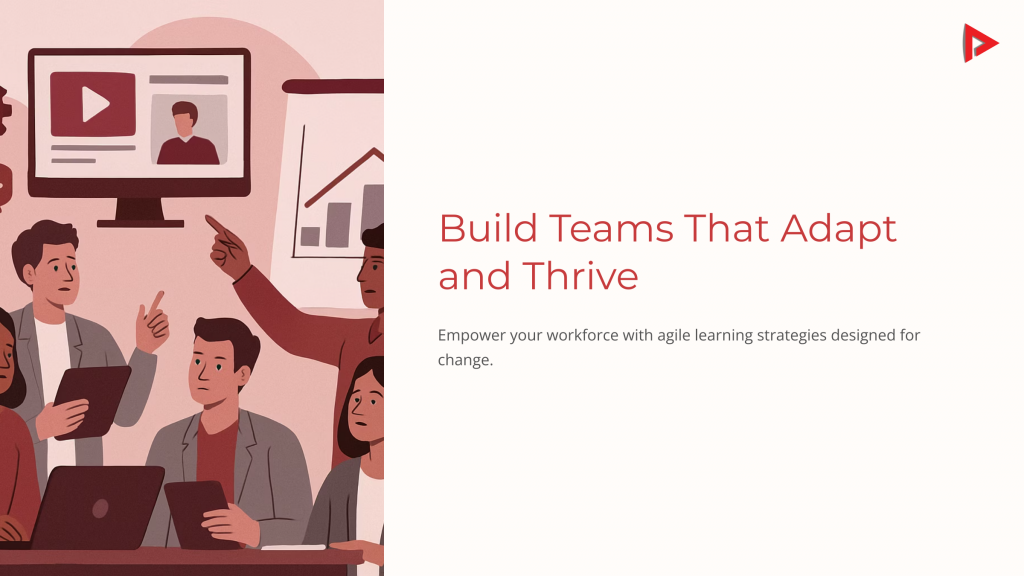
Organisations across every sector are grappling with unpredictable change, whether it’s driven by evolving technology, shifting regulations, or the rise of remote and hybrid work models. What sets high-performing teams apart isn’t just their skillset—it’s their agility.
Workforce agility refers to how quickly and effectively individuals and teams can respond to new demands, shift priorities, and adopt fresh ways of working. For HR professionals, corporate training managers, and learning leaders, this raises a critical question: how can corporate eLearning strategies keep pace with change?
Agility as a Strategic Imperative
Agility—at both the individual and organisational level—has become a defining factor in long-term success.
In sectors like energy, for example, teams must continually adapt to new compliance standards, emerging sustainability targets, and evolving digital tools. For HR and learning leaders, that means enabling rapid reskilling, supporting knowledge transfer across roles, and building cultures that embrace change—not resist it.
Agile workforces are not only faster to respond—they’re also better equipped to innovate, collaborate across functions, and maintain momentum in times of uncertainty. They’re the teams that can pivot with purpose, apply learning in the moment, and continue to deliver impact under pressure.
Key Benefits of Corporate eLearning for Agile Workforces
An agile workforce is built on the foundation of continuous, accessible, and responsive learning. Corporate eLearning offers the tools and structure to make that possible—empowering teams to learn in real time, adapt with confidence, and thrive in flux.
Rapid Upskilling and Reskilling
In fast-evolving industries, yesterday’s skills can quickly become outdated. eLearning enables organisations to respond quickly by delivering tailored training that aligns with current needs—whether it’s introducing a new system, meeting a regulatory update, or closing a critical skill gap.
Through microlearning, scenario-based modules, and mobile-friendly content, employees can learn what they need, when they need it—without pulling them away from day-to-day operations.
Result: faster onboarding, smoother transitions, and greater role flexibility across teams.
Cross-Functional Collaboration and Knowledge Sharing
Agile organisations break down silos and encourage shared ownership of knowledge. eLearning platforms can foster this through collaborative learning tools like peer forums, digital workshops, and role-based simulations.
When employees understand how different functions connect, they’re more prepared to work across boundaries and step into new challenges with clarity and confidence.
Result: stronger collaboration, better decision-making, and increased innovation.
Scalable Learning at Speed
Rolling out traditional training across multiple locations or business units can be time-consuming and costly. eLearning offers scalability without compromising on quality—allowing organisations to launch consistent, high-impact learning across regions, departments, or roles with minimal lag time.
And as business needs shift, content can be easily updated to reflect new priorities.
Result: consistent learning experiences that evolve with the business and support growth at scale.
Data-Driven Insights for Continuous Improvement
Agile organisations rely on feedback loops—and eLearning delivers them. From learner analytics to assessment outcomes, digital platforms provide rich insights into how content is being used, what’s working, and where gaps exist.
This enables learning and development teams to iterate quickly, refine learning strategies, and stay aligned with performance goals.
Result: a smarter, more responsive learning ecosystem that evolves with your workforce.
Best Practices for Implementing an Agile Employee Development Strategy
Agility in learning doesn’t come from simply digitising existing content—it comes from rethinking how learning is designed, delivered, and embedded into daily work.
Start with Business-Critical Needs
Agile learning starts by aligning with real business objectives. Instead of casting a wide net, focus on the areas where rapid upskilling will drive the most value. Work closely with stakeholders to identify where agility is most needed and design learning outcomes around those priorities.
Design for Flexibility and Relevance
An agile workforce needs learning that adapts to their context—not the other way around. Embed real-world applications that allow employees to practice and apply skills immediately.
Tip: Don’t aim for perfection on day one. Design content that can evolve based on feedback and performance data.
Enable Just-in-Time Access with Digital Learning for Businesses
Agility means being able to respond in the moment. Ensure learning is accessible across devices, locations, and time zones so employees can engage at the point of need. Integrate learning into existing workflows with tools like performance support widgets, job aids, and embedded learning prompts within digital platforms.
Foster a Culture of Continuous Learning
eLearning alone won’t create agility—it must be paired with a culture that values growth, experimentation, and knowledge sharing. Encourage managers to model learning behaviours, celebrate quick wins, and build learning into team rhythms. Create space for feedback and iterate based on what learners actually need—not just what’s easy to deliver.
Agility Starts with Empowerment
For leaders in HR, L&D, and operations, the opportunity is clear: invest in learning strategies that don’t just inform—but empower. Create learning experiences that inspire action, drive results, and equip teams to meet complexity with clarity.
Agility doesn’t happen by accident—it’s a designed outcome. And with the right partner, it’s absolutely within reach.
Let’s reimagine what’s possible when learning becomes your organisation’s most agile asset. Contact Anderson Studios today to get started.

